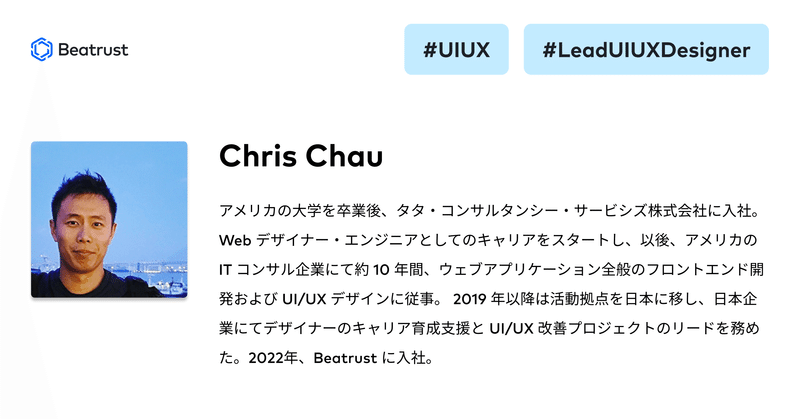
UI/UX デザイン - カルチュラル コンテキスト(日本とアメリカの違い)/ Cultural Context (Japan vs US)
*Please scroll to the bottom of the page for the English version.
*英語版はページ下部にあります。スクロールしてご覧下さい。

皆さん、こんにちは。
クリスと申します。現在 Beatrust で UI/UX リーダーデザイナーとして働いています。

3 年程前に仕事の為に日本へ引っ越してきました。その前はアメリカで約 15 年程 UI/UX デザイナーとして働いていました。日本へ来てからも尚、毎日新しいことを学び続けています(楽しいです!)。
そこで私自身が今までに体験し、デザイナーとしての目線で見て感じた日本とアメリカの違いなどを皆さんとシェアしたいと思います。
これからお話しする事に皆さんが興味を持って頂けると嬉しいです。
Cultural Context(カルチュラル コンテキスト)
まず初めに、Cultural Context にフォーカスしてお話ししていきたいと思います。かなり高いレベルで Culture 文化というのは Low-Context と High-Context として表すことができます。
例として、アメリカは Low-Context Culture だと言えます。アメリカは直接的なコミュニケーションの取り方をします。情報が明示的に記載されています(例;イエスかノーで答え、中間はない)。
それとは逆に、日本は High-Context Culture の国と言えるでしょう。
日本人は豊かな言語の使い回しや、言葉以外での表現方法を使います(例;ジェスチャーや声のトーンの変化など)。
なぜそれが UI/UX に関係するのか?
アメリカでは大抵の場合、情報は関連性の高い方法で表示されます(例;関連性のあるものだけを集めてグループ化します)。
そして、関係のない情報はあまり出さないようにします(例;イメージ画像、そしてタイトルは載せるけれど、あちこちに広告やラベルをつけるような、複雑でごちゃごちゃしたものにはしない)。
アメリカでは、意味のある文脈(Context)と意味を作る為にレイアウトと UI を使います。
例えば、上の US Toyota Corolla Website を見てわかるように、バナーやイメージ画像、 Video、そしていくつかのキーワードを使っているだけで、とてもシンプルに仕上がっています。
ギャラリーページを開くと、そこには主にイメージ画像のみが使用されておりとてもシンプルです(なぜならそのページの名前がギャラリーだからです!)。
それは良い UI/UX でしょうか?それはさほど重要なことではありません。
重要なのは、この方法が、アメリカ人が期待する情報の表し方であるということです。
もし、このウェブサイトと同じものを日本市場に持ち込んだ場合、どうなるでしょうか?
個人的な意見ではありますが、あまり上手くいかないのではないかと思います。
あるリサーチによれば、多くの日本人は、アメリカ版のウェブサイトは断片化されており、情報が統合されていないと考えるそうです。たくさんの写真を見るのに何度も画面をスクロールしなければならない事を好まないようです。
こちらのウェブサイトを見てみると、一番最初のページにバナー、イメージ画像、価格、保険情報、トランスファー比較、チャットボットなど色々な情報を見ることができます。
このウェブサイトから、日本人は、詳細かつ包括的で高密度の情報が詰まったものを好むということがわかります。
更に、High-Context Culture (日本)の人はウェブサイトに、情報だけでなく感動などの感情的な要素を求める傾向にあります。
例えば、US Toyota Website は約 90% ホワイトカラーを使用しており、シンプルすぎてトヨタのブランドイメージとマッチしていない、と多くの日本人は考えるようです。
では、 UI/UX デザイナーはどうするべきなのでしょうか。
UI/UX デザイナーたちは、デザインを始める前に、それぞれユーザーの文化の違いを知った上で、彼らの期待に応えられるように変化させていくことが大事だと言えます。
残念ですが、"One Rule to Rule Them All" 「全てを支配する一つのルール」というものは単に存在しません。
私たちは、学校や本、 YouTube などから沢山の事を学べますが、実際の生活の中や仕事の環境ではその知識を活かせないこともあります。
“Flexible & Balanced”「柔軟でバランスのとれた状態」が今回の重要な勝利の鍵です。
終わりに
最後まで読んでいただき、ありがとうございました。
皆さんは、デザイナーとして働く上で、この文化の違いなどの問題にぶつかる事はありませんか?
よろしければ、コメントで一緒にシェアしましょう。
Beatrust が目指している製品は、どんな国の文化であろうと関係なく、誰もが使いやすい製品です。私たちはこれから日本国内だけでなくすべての国のユーザーに向けてデザインをしていきます。
また、Beatrust では一緒に働いていける仲間を募集しています。興味がある方はお気軽にお声がけください!

Hi all!
My name is Chris. I work as a lead UI/UX designer in Beatrust in Japan.
I moved to Japan for work almost 3 years now. Before that, I was working in the US for about 15 years as an UI/UX designer. I am still learning new things daily here in Japan. I would like to take a moment, to share things that I see and feel differently from a designer's point of view. Hope you all find it interesting!
Cultural Context
Today, I would like to focus on cultural context. In a super high level, culture can be defined as low-context or high context.
For example, the US is a low-context culture. People communicate in a more direct way. Information is explicitly stated (e.g. Yes or No? Tell me which one!).
On the other hand, Japan is a high-context culture country. Japanese people use richer verbal and non-verbal cues (e.g. gestures and tones of voice) to facilitate communication.
So, why does it matter to UI/UX?
In the US, people typically expect information displayed in a highly related manner (e.g. only related things should group together), and only few things at a time (e.g. you see an image, maybe a title, but never complicated overlay labels here and there), etc. They use the layout and UI to create a meaningful context and meaning.
As an example, in the US Toyota Corolla website, you see a banner, an image or video, few keywords, and that's it. In the gallery page, you will see only images and nothing else (because the page name is gallery!). Is it a good UI/UX? It is not important here. The key is, this is the way that people in the US expect information to flow.
What if Toyota copy that style into Japanese market?
I personally don't think that would work. According to a local research, some Japanese people think the website has fragmented information. They think information is not integrated. They don’t want to scroll several times only to see a handful of pictures.
In Japan Toyota Corolla website, on just the first page, you can see banners, images, pricing, insurance info, transfer comparison, chat bot, and many more. Instead, Japanese people prefer much more detailed info, comprehensive, and denser like the Japan Toyota website.
Also, high-context culture people are more likely to show their emotional responses towards website. For example, some Japan people think the US Toyota website uses only white color (> 90%), and it does not fit Toyota's branding image.
What should UI/UX designers do?
For UI/UX designers, before we actually do the design, it’s always important to learn about the cultural differences, and how they can potentially change users’ expectations.
"One Rule to Rule Them All" simply does not exist. Things that we learn from books, schools, YouTube are good information, but, sometimes we just cannot apply those knowledges into the real world directly.
“Flexible & Balanced” is the key to win here.
Lastly
Thanks so much for your support! Do you all designers face to any design problems for different cultures? Let's share in the comment together.
For Beatrust, we would like to build an application that fits different cultures and have a good UI/UX for everyone. And, we are not just targeting Japanese market, we are in the progress to reach everyone via good UI/UX.
By the way, Beatrust is hiring for different positions. Please take a look if you are interested in it. Let's build something fun together!
Till next time!

Beatrust は、2020 年に創業してから早くも 2 年間が経ちました。様々なグローバル企業やスタートアップなどで経験を積まれたメンバーが、お互いを刺激し合いながら日々仕事をしているアーリーステージのスタートアップ、最近も素敵なバックグラウンドを持った社員が続々と参画してくれています。次回の記事もお楽しみに!
ご興味をもった方は、ぜひほかのメディアや、Beatrust に関するニュースリリースもご覧ください!また、取材依頼やそのほか本記事に関するお問い合わせは marketing@beatrust.com までお願い申し上げます。
(現在取材などのご依頼が非常に多いため、ご回答までお時間をいただく場合がございます。)
ニュースリリース
この記事が気に入ったらサポートをしてみませんか?
